
 i_need_contribute
i_need_contribute
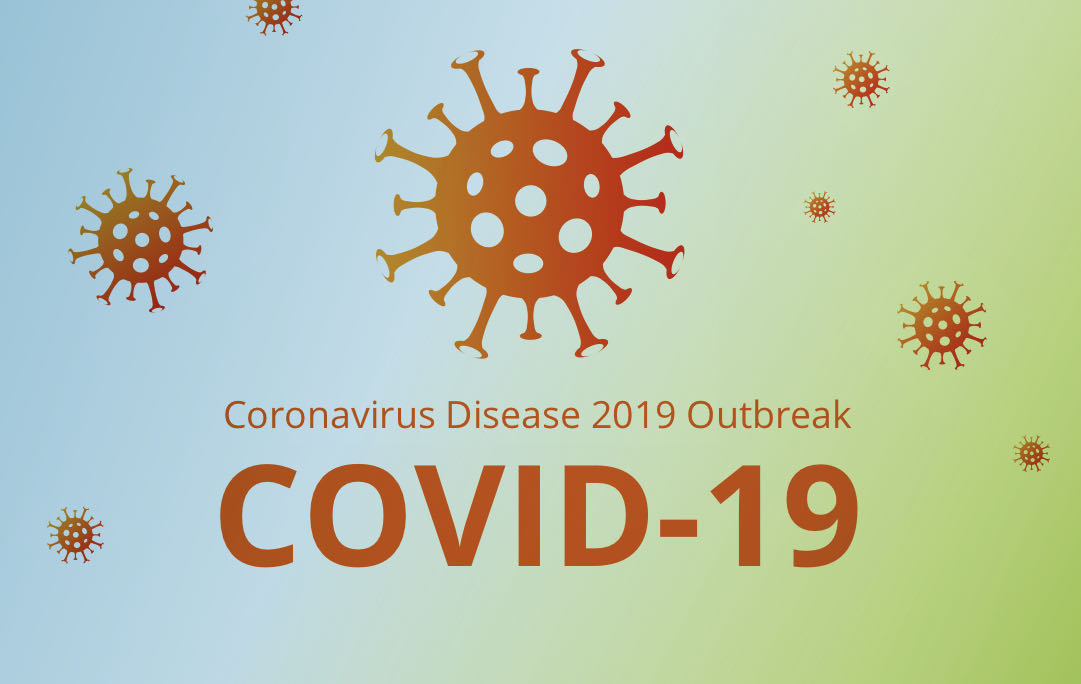

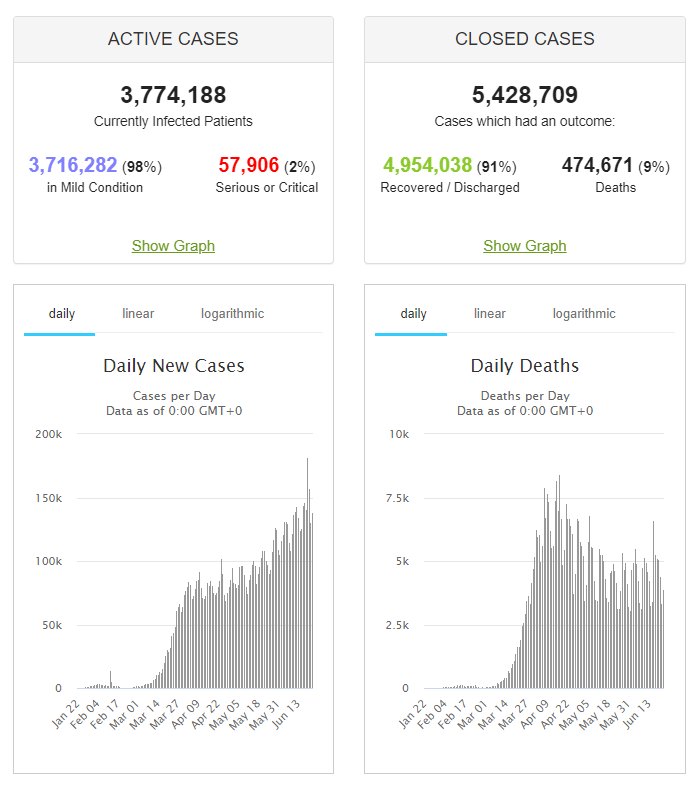
|
# |
Country, |
Total |
New |
Total |
|
|
World |
9,180,875 |
+138,975 |
473,484 |
|
1 |
2,388,153 |
+31,496 |
122,610 |
|
|
2 |
1,111,348 |
+24,358 |
51,407 |
|
|
3 |
592,280 |
+7,600 |
8,206 |
|
|
4 |
440,450 |
+13,540 |
14,015 |
|
|
5 |
305,289 |
+958 |
42,647 |
|
|
6 |
293,584 |
+232 |
28,324 |
|
|
7 |
257,447 |
+2,511 |
8,223 |
|
|
8 |
246,963 |
+4,608 |
4,502 |
|
|
9 |
238,720 |
+221 |
34,657 |
|
|
10 |
207,525 |
+2,573 |
9,742 |
|
|
11 |
192,119 |
+544 |
8,969 |
|
|
12 |
188,897 |
+1,212 |
4,974 |
|
|
13 |
181,088 |
+4,471 |
3,590 |
|
|
14 |
180,545 |
+5,343 |
21,825 |
|
|
15 |
161,005 |
+3,393 |
1,307 |
|
|
16 |
160,750 |
+373 |
29,663 |
|
|
17 |
115,786 |
+3,480 |
1,502 |
|
|
18 |
101,637 |
+300 |
8,436 |
|
|
19 |
101,590 |
+4,288 |
1,991 |
|
|
20 |
88,403 |
+1,034 |
99 |
|
|
21 |
83,396 |
+18 |
4,634 |
|
|
22 |
71,183 |
+2,531 |
2,310 |
|
|
23 |
60,550 |
|
9,696 |
|
|
24 |
59,023 |
+518 |
351 |
|
|
25 |
58,932 |
+84 |
5,122 |
|
|
26 |
56,809 |
+1,576 |
2,278 |
|
|
27 |
50,640 |
|
4,223 |
|
|
28 |
49,658 |
+65 |
6,090 |
|
|
29 |
46,845 |
+954 |
2,500 |
|
|
30 |
45,303 |
+378 |
303 |
|
|
31 |
44,931 |
+2,146 |
1,043 |
|
|
32 |
42,313 |
+218 |
26 |
|
|
33 |
40,291 |
+641 |
330 |
|
|
34 |
39,392 |
+259 |
1,534 |
|
|
35 |
37,241 |
+681 |
1,012 |
|
|
36 |
32,676 |
+1,808 |
1,167 |
|
|
37 |
32,227 |
+296 |
1,359 |
|
|
38 |
31,310 |
+18 |
1,956 |
|
|
39 |
31,076 |
+1,605 |
137 |
|
|
40 |
30,682 |
+630 |
1,177 |
|
|
41 |
29,157 |
+324 |
598 |
|
|
42 |
27,370 |
+693 |
669 |
|
|
43 |
26,752 |
+722 |
521 |
|
|
44 |
25,383 |
+4 |
1,717 |
|
|
45 |
24,388 |
+876 |
773 |
|
|
46 |
24,291 |
+246 |
1,523 |
|
|
47 |
22,407 |
+643 |
65 |
|
|
48 |
21,082 |
+304 |
307 |
|
|
49 |
20,919 |
+675 |
525 |
|
|
50 |
20,588 |
+320 |
360 |
|
|
51 |
17,916 |
+52 |
953 |
|
|
52 |
17,732 |
+507 |
127 |
|
|
53 |
17,380 |
+39 |
690 |
|
|
54 |
14,363 |
+163 |
480 |
|
|
55 |
14,154 |
+147 |
85 |
|
|
56 |
13,207 |
+478 |
161 |
|
|
57 |
13,145 |
+390 |
531 |
|
|
58 |
12,990 |
+96 |
262 |
|
|
59 |
12,772 |
+466 |
363 |
|
|
60 |
12,527 |
+136 |
602 |
Source:https://www.worldometers.info/coronavirus/

Worshipers in Mecca in April.Credit...Agence France-Presse — Getty Images
Every year, Saudi Arabia plays host to millions of Muslims from around the world taking part in the pilgrimage to Mecca known as the hajj. It is a sacred rite for Muslims and a reliable source of income for the Saudi economy and of prestige for its monarchy.
But not this year.
The kingdom announced on Monday that the hajj, which is taking place next month, would welcome “very limited numbers” of pilgrims to prevent the spread of the coronavirus.
In a statement published by the state-run Saudi Press Agency, the Ministry of Hajj and Umrah, which oversees the pilgrimage, said the event would allow only Saudi pilgrims and those from other countries already inside the kingdom.
The ministry did not specify the target attendance, but the limitations will surely make this year’s pilgrimage much smaller than those in recent years, which have been vast.
In 2019, 2.49 million pilgrims took part in the hajj, according to the Saudi General Authority for Statistics, and 1.86 million of them came from abroad.
The reduced numbers could strike a big financial blow to a kingdom already reeling from low oil prices and an economic slowdown caused by the lockdown. The holy cities of Mecca and Medina are likely to be especially hard hit.
For the many Muslims planning to make the pilgrimage, it will also be a major disappointment. The hajj is one of the five pillars of Islam, and a journey every Muslim who is able must undertake once in a lifetime.
Muslims who have spent years saving for the trip and jockeying for bookings will now have to wait until next year to try again.
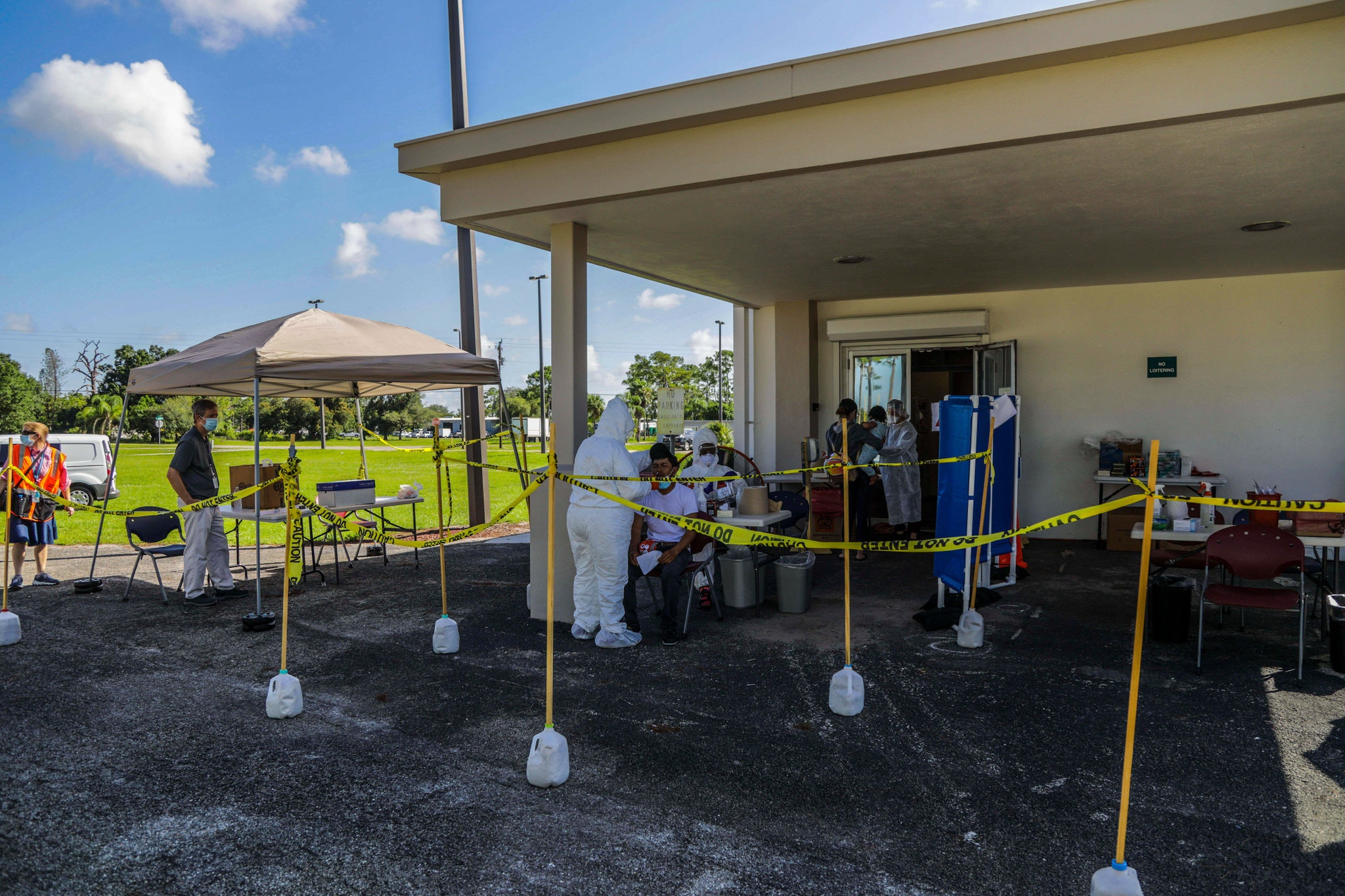
A walk-up testing site in Immokalee, Fla., this month.Credit...Saul Martinez for The New York Times
As the virus spreads at record speeds around the world, the United States accounted for 20 percent of all the new infections worldwide on Sunday, according to New York Times data, even as the country’s population makes up about 4.3 percent of the world’s.
New cases continued to surge over the weekend in 22 states, especially in the West and the South. Oklahoma and Missouri reported their largest single-day case increases yet on Sunday.
Over the weekend, Florida also passed 100,000 cases according the state’s health department and the surgeon general there began formally advising that all residents wear face coverings “in any situation where social distancing is not possible.” In Miami, Mayor Francis Suarez went further on Monday, making it a requirement that residents wear masks in public, effective immediately.
In Washington’s Yakima County, where the number of cases has more than doubled in the past month, the situation is dire. Gov. Jay Inslee said the county was at a “breaking point.” With a shortage of hospital beds, patients were being taken to Seattle, more than two hours away, for medical care. Yakima hospitals are also reporting significant staffing shortages because of employees who are sick with the virus or are under a 14-day quarantine after being exposed.
In the wake of another record-setting day for new cases, Dr. Michael Ryan, the executive director of the W.H.O.’s health emergencies program, said on Monday that increased testing was not driving the surge in cases.
“We do not believe that this is a testing phenomenon,” he said. “Clearly, hospital admissions are also rising in a number of countries, deaths are also rising, and they are not due to increase testing, per se. So there definitely is a shift in the sense that the virus is now very well established at the global level.”
The declaration comes two days after Mr. Trump told supporters at a political rally in Tulsa, Okla., that he had urged U.S. officials to slow down testing for the virus. Mr. Trump has attributed the recent upswing of cases in the United States to increased testing.
Dr. Tedros Adhanom Ghebreyesus, the director general of the W.H.O., said on Monday that more than 183,000 new cases worldwide were reported in the last 24-hour period, “easily the most in a single day so far.”
He also warned countries not to make the virus a political issue, particularly as infections worldwide are on the rise.
“We know the pandemic is so much more than a health crisis — it’s an economic crisis, a social crisis and in many countries a political crisis,” Dr. Tedros said. Though he did not call out specific countries, the virus has become politically contentious in several countries, including the United States, where the White House has begun rolling back its own virus-related precautions, and Brazil.
、

Barbara Ferrer, Los Angeles County’s Public Health Director, said she began receiving death threats last month.Credit...Damian Dovarganes/Associated Press
Leaders of local and state health departments have been subject to harassment, personal insults and death threats in recent weeks, a barrage of abuse from a vocal and angry segment of the population who say that mask requirements and restrictions on businesses have gone too far.
The steadily escalating threats prompted one top health official, Dr. Barbara Ferrer, the director of the Los Angeles County Department of Public Health, to issue a statement on Monday condemning attacks on public health directors and disclosing that she has been living with repeated threats to her safety.
“In my case, the death threats started last month, during a Covid-19 Facebook Live public briefing when someone very casually suggested that I should be shot,” Dr. Ferrer said in a statement. “I didn’t immediately see the message, but my husband did, my children did, and so did my colleagues.”
“It is deeply worrisome,” she added, “to imagine that our hardworking infectious disease physicians, nurses, epidemiologists and environmental health specialists or any of our other team members would have to face this level of hatred.”
Many public health officials entered the coronavirus pandemic this year with bare-bones staffing and strained budgets, leaving them ill-prepared to handle the mounting crisis.
Lori Tremmel Freeman, the chief executive of the National Association of County and City Health Officials, said in an interview last week that dozens of top health officials have resigned or been fired since the pandemic began.
“There’s a big red target on their backs,” she said. “They’re becoming villainized for their guidance. In normal times, they’re very trusted members of their community.”
The White House on Monday began easing virus-related restrictions it has had in place since March, even as the Trump campaign announced that two more campaign aides had tested positive.
Temperature checks at the complex will be scaled back, allowing many White House staff members who have been working remotely to return to their offices. And the cafeteria in the Eisenhower Executive Office Building, across the street from the West Wing, will be reopened.
But assuring that Mr. Trump and Vice President Mike Pence will not be exposed to the virus by visitors remains a priority.
“Every staff member and guest in close proximity to the president and vice president is still being temperature-checked, asked symptom histories and tested,” Judd Deere, a White House spokesman, said in a statement.
Mr. Deere said that White House officials would continue to practice social distancing, use hand sanitizer and wear face masks on a voluntary basis, and that the work spaces would be deep cleaned regularly.
In announcing the new guidelines, the White House followed the lead of the City of Washington, which began the second phase of its reopening on Monday.
The White House guidelines also reflect Mr. Trump’s emphasis on returning to normal. They were put in place just days after he staged a “comeback” rally in Tulsa, Okla., where he tried to pack an indoor arena with 19,000 people.
Tim Murtaugh, a campaign spokesman, said in a statement on Monday that the two staffers who had tested positive “attended the rally but were wearing masks during the entire event.”
“Upon the positive tests, the campaign immediately activated established quarantine and contact tracing protocols,” he added.
The news brought to eight the number of Trump campaign advance staffers who have tested positive in recent days. Six aides who had worked on the event had tested positive on Saturday, hours before the rally, and did not attend. The rally drew 6,200 people, according to the Tulsa Fire Department.
Democrats pounced on Monday on Mr. Trump’s claim during the Tulsa rally that he had asked his “people” to “slow the testing down” so they might find fewer cases, pressing top administration officials on Monday to provide records and internal assessments related to the sharp uptick in cases across the country.
Representative James E. Clyburn, Democrat of South Carolina and the chairman of a special virus oversight committee, wrote to Mr. Pence and top health officials asking for details on what the Trump administration was doing to control the spread.
“No American should go untested because the president fears an accurate count of infections, and there is nothing ‘overblown’ about saving American lives,” Mr. Clyburn wrote.
As parts of the country tentatively reopen, clusters of cases have spread from the most widely known locations — like meatpacking plants, nursing homes and prisons — to locations that have gotten far less attention.
Four people who spent time at Cruisin’ Chubbys Gentlemen’s Club, a Wisconsin strip club, recently tested positive. In Colorado, at least 11 staff members at Eagle Lake Overnight Camp came down with the virus before any campers showed up, leading the camp to close for the rest of the summer.
Other clusters have been linked to fraternity rush parties in Mississippi. Officials said those gatherings appeared to violate rules that ban indoor gatherings of more than 20 people unless social distancing steps are taken.
And in Connecticut, the city of New Haven shut down a nightclub that the authorities said hosted a gathering of about 1,000 people on Saturday night in its parking lot, violating orders on the size of gatherings.
Many patrons of the club, 50’s Lounge, were not wearing masks and were not practicing social distancing, according to photos and videos that were posted on social media. One of the club’s owners wrote in a Facebook post that the shutdown was racially motivated and that people of color were viewed as public nuisances. The patrons were predominantly African-American.
Churches, whose reopenings have been debated, are also emerging as sources of major clusters around the country. At least 236 cases were recently linked to Lighthouse Pentecostal Church in Oregon.
Experts say clusters will likely continue to crop up as people come into more contact with one another.
“Reopening is part of the story,” said Dr. Arnold S. Monto, a professor of epidemiology at the University of Michigan School of Public Health, who noted that as states get back to business, more people will be at risk. But the virus is also notoriously erratic, he said, leaving certain people more likely to transmit it than others.
“You have individuals who are super spreaders,” he said, not because they are irresponsible, but because there is something different in how their body reacts to the virus. “It’s a biological phenomenon we do not understand.”
President Trump on Monday signed a proclamation temporarily suspending work visas and barring more than half a million foreigners from coming to work in the United States, part of a broad effort by the administration to dramatically limit entry into the country during the economic downturn caused by the coronavirus pandemic.
The restrictions would block entry into the United States under the H-1B visa program for high-skilled workers, and would also affect several other categories of visas, although it would exempt health care professionals and farm workers, among others. Taken together, senior administration officials said, the worker visa bans and green card suspensions would prevent 525,000 immigrants from working in the United States between now and the end of the year.
The order, which has been expected for several weeks, is fiercely opposed by a broad swathe of businesses — including high tech companies in Silicon Valley, manufacturers, and others — whose leaders say it will block their ability to recruit critically needed workers from overseas countries for jobs that Americans cannot or will not perform.
Stephen Miller, the architect of the president’s restrictive immigration policies, has pushed for years to limit or eliminate the worker visas, arguing that they harm employment prospects for Americans. In recent months, he has argued that the economic distress caused by the virus has made it even more important to turn off the spigot of foreign entry into the United States.
In April, the president signed an executive order that suspended for 60 days the issuance of green cards to foreigners looking to live in the United States. But at the time, Mr. Miller and the president bowed to pressure from the business community to avoid imposing limits on worker visas.
Monday’s order extends the green-card prohibition in addition to suspending the issuance of many of the worker visas, which will be effective through the end of the year. In addition, the administration officials said that the president would order new regulations to permanently change worker visas in the future so that foreign job offers go to more highly paid, highly-skilled workers that will compete less with Americans.
Germany is scrambling to contain a fast-growing outbreak in the country’s largest pork processing plant.
The authorities have confirmed 1,331 new cases among workers at the Tönnies plant in the northwestern town of Rheda-Wiedenbrück in the last week. The surrounding community has been quarantined and schools and day care centers have been closed. State and federal health workers and soldiers had been deployed to carry out large-scale testing.
Some workers blamed a lack of safety measures and space to practice social distancing. A video released in early April, apparently recorded by a worker, showed a crowded cafeteria. The state prosecutor said he was considering opening an investigation.
In other international news:
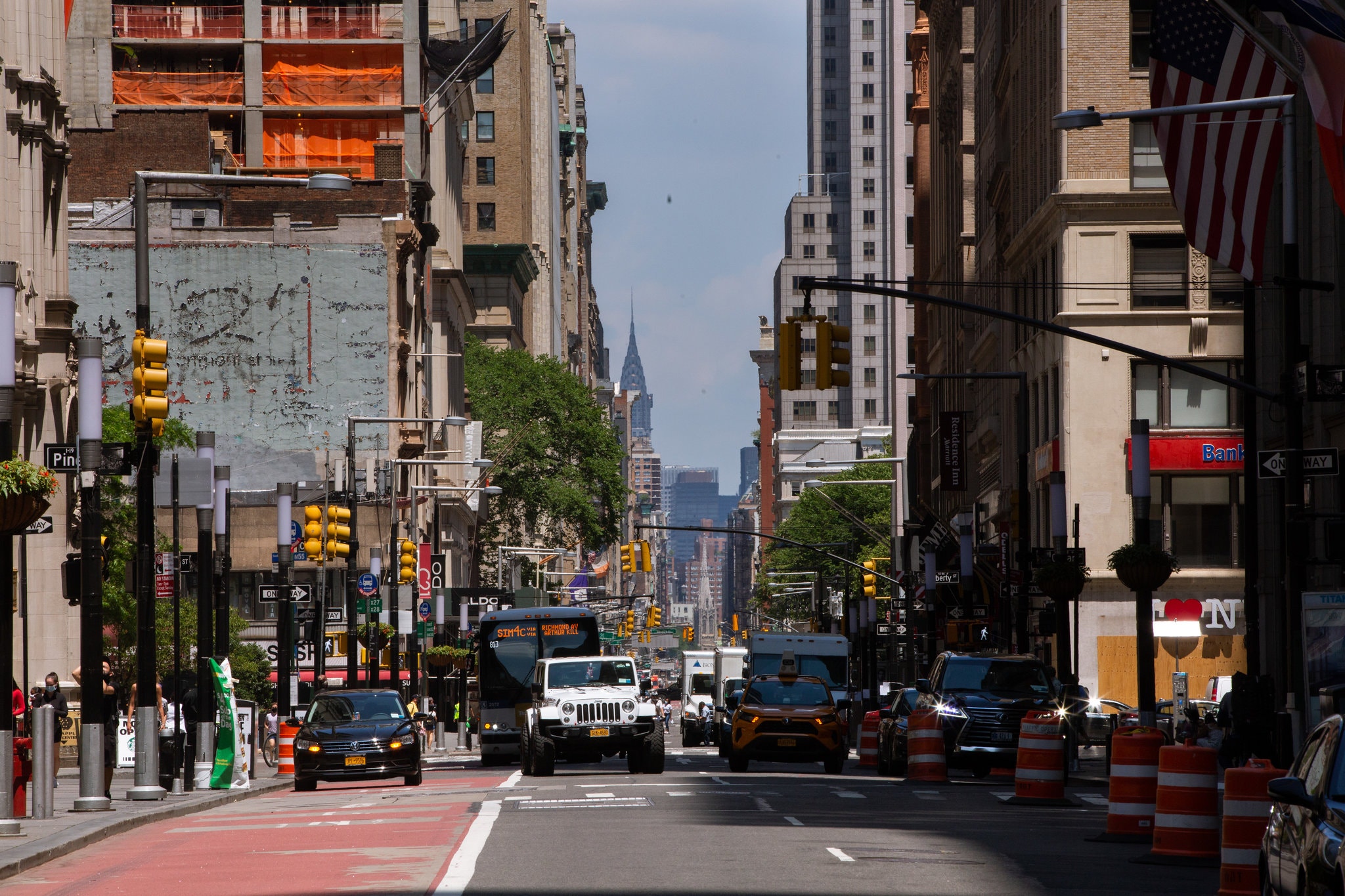
The Financial District in Manhattan on Monday.Credit...Amr Alfiky/The New York Times
Two weeks after it began easing virus restrictions, New York City reached another major milestone on Monday, as offices were allowed to open and as many as 300,000 people were expected to return to work in person.
Phase 2 of reopening also allows for outdoor dining, some in-store shopping, hair salons, barbershops and real estate work.
At his daily briefing on Monday, Mayor Bill de Blasio called it “a giant step for this city.”
“This is where most of our economy is,” he said.
Still, with offices required to limit their maximum capacity to ensure social distancing, the number of people returning to work appeared to be a fraction of those who once jostled elbows on crowded subways and in high-rise elevators.
“It’s nice to get back to kind of normal, even though it’s not 100 percent normal,” said Kiki Boyzuick, 45, who works in human resources in Midtown Manhattan.
On Monday morning, a time when Midtown would typically be crammed with workers, the sidewalks remained largely vacant and the subway cars still felt relatively empty.
The mayor said that while some businesses might be reluctant to reopen their offices in the summer, he would encourage them to bring workers back in the fall.
“The more that people see it’s working, the more people will want to come back,” he said. “I think a lot of businesses will say, ‘We just cannot get done this work as well if people don’t spend more time together.’”
In a survey conducted this month by the Partnership for New York City, a business group, respondents from 60 companies with Manhattan offices predicted that only 10 percent of their employees would return by Aug. 15.
At Fancy Wave Salon in Flushing, Queens, hairstylists wore face shields, gloves and masks as they attended to their clients’ hair. Derrick Chan, the owner, said he was thrilled to reopen.
“We had to pretty much stay home, no income,” he said. “That’s why you have to save up for the rainy days.”
Here’s what else is happening in the region:
More riders returned to public transportation during Phase 1 in New York City than transit officials had anticipated. On the subway, daily ridership has climbed to 17 percent of pre-pandemic levels, when ridership exceeded five million. The Metropolitan Transportation Authority expects as many as two million people during Phase 2.
Regarding Phase 3, Mr. de Blasio said Monday the city would wait the state-mandated minimum of two weeks, and that officials would need to see particular evidence of the outbreak easing.
“It’s going to be of course a higher bar because to do something here affects so many millions of people,” he said.
Gov. Andrew M. Cuomo of New York said Monday on CNN that he was discussing, with the governors of New Jersey and Connecticut, what to do about travelers coming from other states recording increases in cases, even as he described a quarantine by Florida imposed on New Yorkers in March as “more political than anything else.”
“I wouldn’t target a specific state,” he said. “I would consider states with the highest transmission rate, that if somebody comes from that state to New York, there’s a period of quarantine where they quarantine themselves to make sure they’re not spreading it.”

Dining alfresco in Stockholm last month. Sweden, now alienated by its Nordic neighbors, did not place many restrictions on its residents in response to the coronavirus.Credit...Jonathan Nackstrand/Agence France-Presse — Getty Images
While Scandinavian countries like Norway, Denmark and Finland went into strict lockdowns this spring, Sweden famously refused, and now has suffered roughly twice as many infections and five times as many deaths as the other three nations combined, according to figures compiled by The New York Times.
Though reporting differences can make comparisons inexact, the overall trend is clear, as is Sweden’s new status as Scandinavia’s pariah state.
Swedish officials, including the architect of the country’s measures to stop the spread of the coronavirus, Anders Tegnell, say Swedes have been stigmatized by an international campaign to prove Sweden was wrong and warn their neighbors that they are going to be much more vulnerable if a second wave of the virus hits in the fall.
“We are really confident that our immunity is higher than any other Nordic country’s,” Mr. Tegnell said during a news conference last week. He added that while Sweden was not striving for so-called herd immunity, the higher level of immunity “is contributing to lower numbers of patients needing hospitalization, as well as fewer deaths per day.”
Mr. Tegnell also said that infections in Sweden “had peaked,” and were now falling, a trend reflected in The Times’s figures.
Experts in the other Scandinavian countries say the higher immunity levels have not been proven through rigorous testing, and that such talk misses a major point.
“When you see 5,000 deaths in Sweden and 230 in Norway, it is quite incredible,” said Gro Harlem Brundtland, a former prime minister of Norway and the former director of the World Health Organization, during a digital lecture at the Norwegian Academy of Science and Letters in May. “It will take a lot to even out this difference a year or two into the future.”

Father Eduardo Vasquez, left, and a fellow priest, Rey Amancio, offering prayers for the dead in Caloocan, a city in Manila, in May.Credit...Jes Aznar for The New York Times
When Manila was placed under lockdown in March, Father Eduardo Vasquez moved his daily Mass online. That kept him safe from the coronavirus but left some of his poorest parishioners — the ones without cellphones — beyond his reach.
So he set off to find them. In the city’s teeming slums, already reeling from President Rodrigo Duterte’s bloody antidrug campaign, he celebrated Mass, served the Eucharist, and distributed food and face masks.
“Journalists, doctors, garbage collectors and undertakers were out doing their duties” during the lockdown, he said in the city of Caloocan, the district of Manila where he works. “It’s a big knock on the Catholic Church if we don’t.”
The Philippines has nearly 1,200 deaths from Covid-19 and more than 30,000 confirmed coronavirus cases, one of Southeast Asia’s highest tallies.
On many days, Father Vasquez, 47, tends to his churchyard garden, baptizes children, and attends to the dead at funeral parlors and crematories.
But when he dresses for work these days, his vestments are as protective as they are holy. His cassock has been replaced by a protective suit, his collar hidden behind an N-95 respirator mask.
All that identifies him as a priest is his stole, a scarf about two meters long, the perfect length to measure an acceptable social distance.
An unprecedented expansion of federal aid has prevented the rise in poverty that experts predicted this year when the pandemic sent unemployment to the highest level since the Great Depression, two new studies suggest.
The studies carry important caveats. Many Americans have suffered hunger or other hardships amid long delays in receiving the assistance, and much of the aid is scheduled to expire next month. Millions of people have been excluded from receiving any help, especially undocumented migrants, who often have American children.
Still, the evidence suggests that the programs Congress hastily authorized in March have done much to protect the needy, a finding likely to shape the debate over next steps at a time when 13.3 percent of Americans remain unemployed.
“Right now, the safety net is doing what it’s supposed to do for most families — helping them secure a minimally decent life,” said Zachary Parolin, a member of the Columbia University team forecasting this year’s poverty rate. “Given the magnitude of the employment loss, this is really remarkable.’’
The Columbia group’s midrange forecast has poverty rising only slightly this year, to 12.7 percent, from 12.5 percent before the virus. Without the March law that provided one-time checks to most Americans and weekly bonuses to the unemployed, it would have reached 16.3 percent, the researchers found. That would have pushed nearly 12 million more people into poverty.

Phoebe Waller-Bridge accepted the award for Best Television Series — Musical or Comedy for “Fleabag” during Golden Globe Awards at The Beverly Hilton Hotel in January 5, 2020.Credit...2020 Nbcuniversal Media, via Getty Images
The 2021 Golden Globes will take place on Feb. 28, a date that the Oscars abandoned last week in pushing its ceremony back. That allows the Globes to retain its place before the Oscars in the calendar.
The Hollywood Foreign Press Association, the small group of journalists that hands out the Globes, did not say how the date would affect eligibility of film and television series, which normally adheres to the calendar year. In other culture and sports news:
From CNN Health’s Jen Christensen
Kathleen Sebelius, former secretary of the US Department of Health and Human Services, says that while the country is doing more testing for Covid-19, we are still “way behind the virus.”
“We are still reacting. We’re not ahead of it,” Sebelius told CNN’s Anderson Cooper on Monday. “The only way to get ahead of the virus is to tamp way down the cases in any area, and then test like crazy when a case appears, contact trace, and make sure you quarantine. We can’t do that yet because we are still finding all kinds of people who have the virus.”
Documented cases continue to grow, as do hospitalizations and deaths in some parts of the country. “We are still not testing enough,” Sebelius said.
Sebelius was critical of US President Donald Trump, who told supporters at a rally Saturday that testing was “a double edged sword.”
"I said to my people, 'Slow the testing down, please,' " he said. Soon after Trump made the comment, White House officials asserted the President was joking.
“We are still not testing enough, but he’s a man who doesn’t want ‘his’ numbers -- whatever those are,” Sebelius said. “Those are patients, as far as I’m concerned -- people who have lost loved ones.”
From CNN's Manveena Suri and Vedika Sud in New Delhi
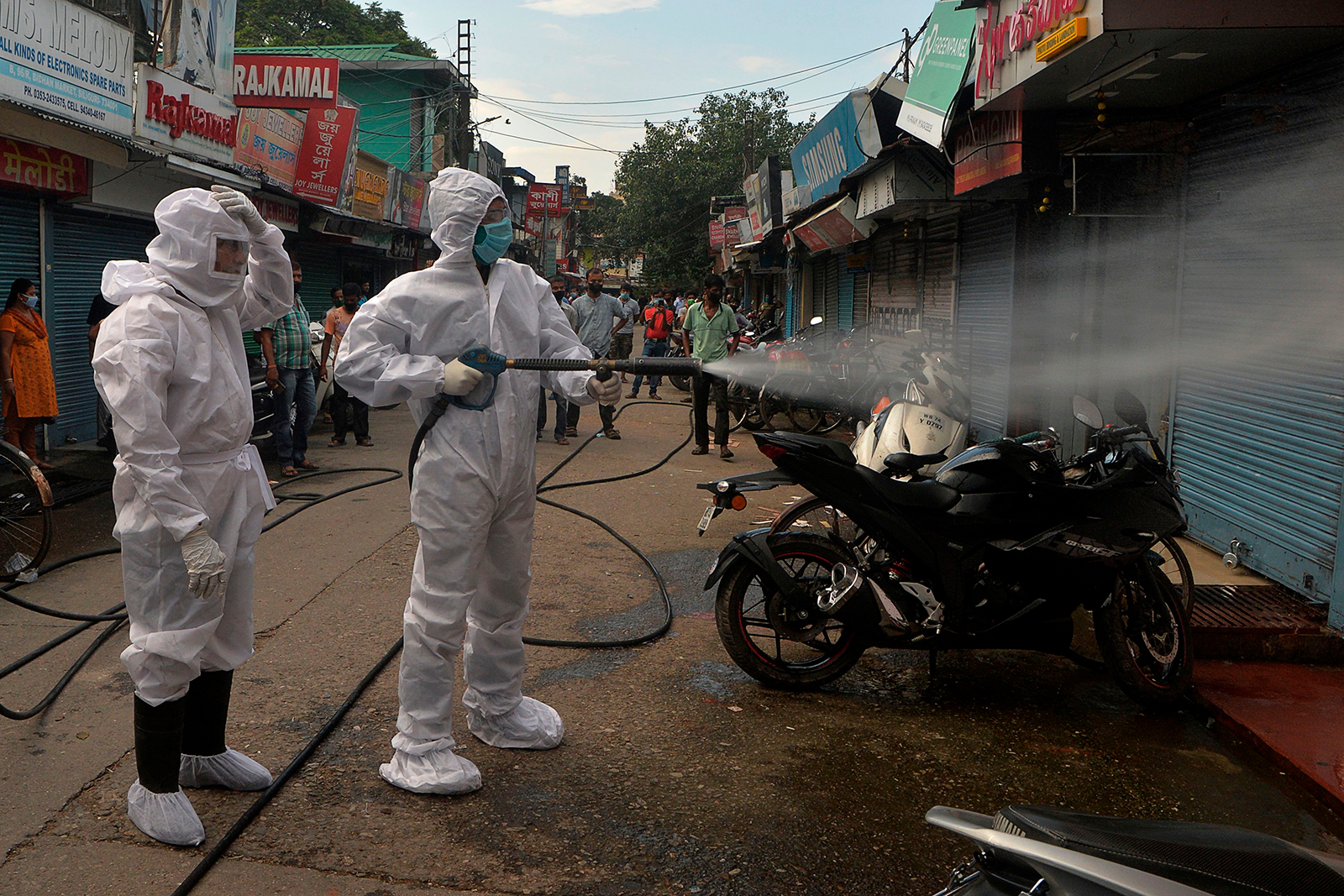
Firefighters wearing personal protective gear spray disinfectant in a closed market in Siliguri, India on June 22. Diptendu Dutta/AFP/Getty Images
India registered 312 new coronavirus-related deaths in the past 24 hours, raising the overall death toll to 14,011, the country's health ministry announced Tuesday morning local time.
The country also added 14,933 new Covid-19 cases, bringing the total number of infections to 440,215.
India, with the fourth highest number of coronavirus cases in the world, has now recorded over 12,000 daily new cases for the sixth consecutive day.
More than 248,000 people have so far recovered from the virus in the country, according to the ministry.
The Indian Council of Medical Research said over 7.1 million coronavirus tests have been conducted across the country since the pandemic began.
From CNN's Natasha Chen in Atlanta
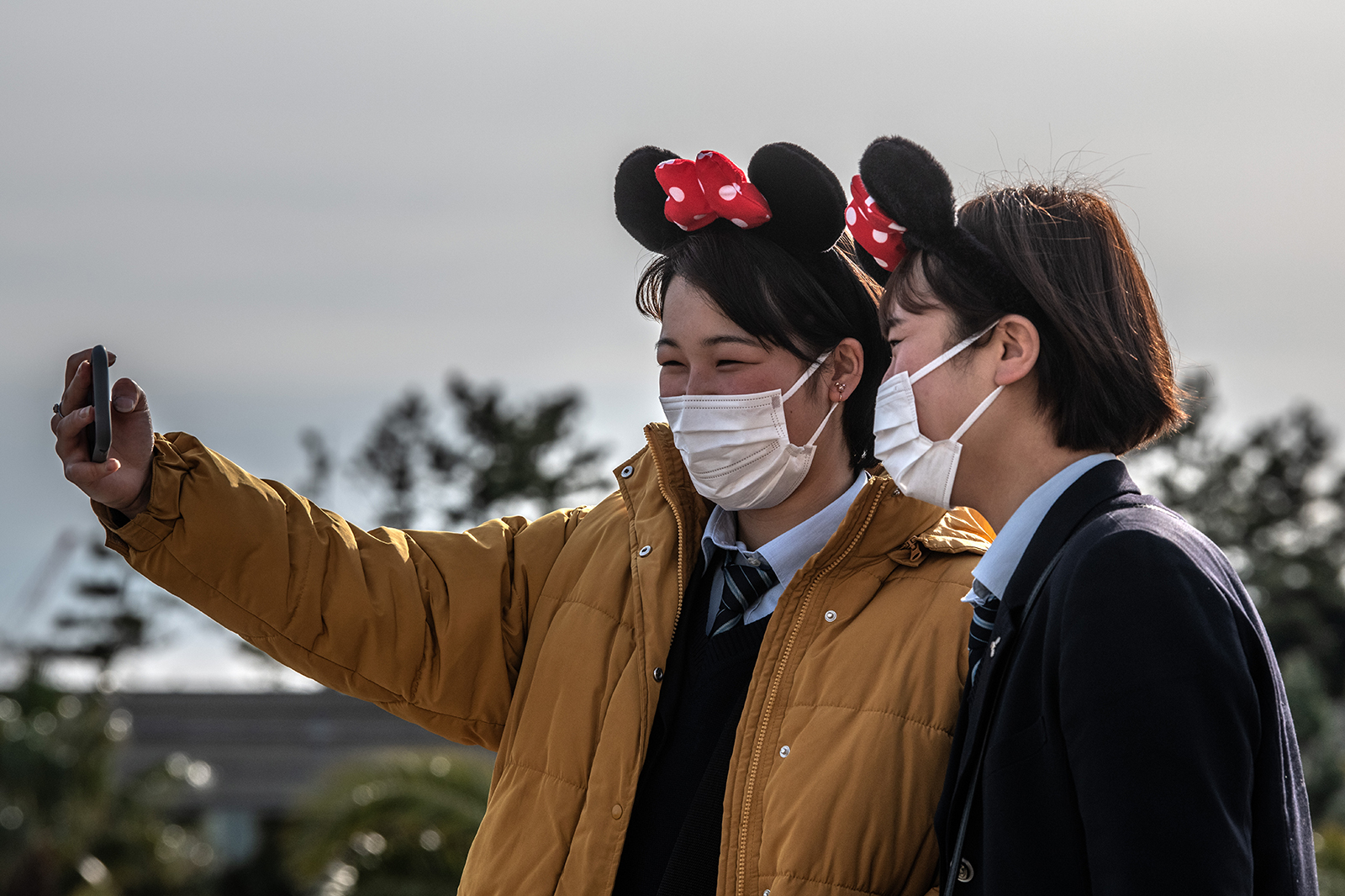
Girls wearing face masks and Disney-themed headbands take a selfie at Tokyo Disneyland on February 28, in Tokyo, Japan. Carl Court/Getty Images
Disney has announced that Tokyo Disneyland and Tokyo DisneySea will reopen on July 1, according to a tweet from one of the company's official Twitter handles.
The resort has been closed since late February due to the coronavirus pandemic.
This is the last of Disney’s global resorts to announce a reopening date after the mass closures following the outbreak of the coronavirus pandemic.
Shanghai Disneyland reopened in May, Hong Kong Disneyland reopened in June, and US and Paris parks are set to reopen in July.
From CNN's Paula Hancocks and Yoonjung Seo in Seoul
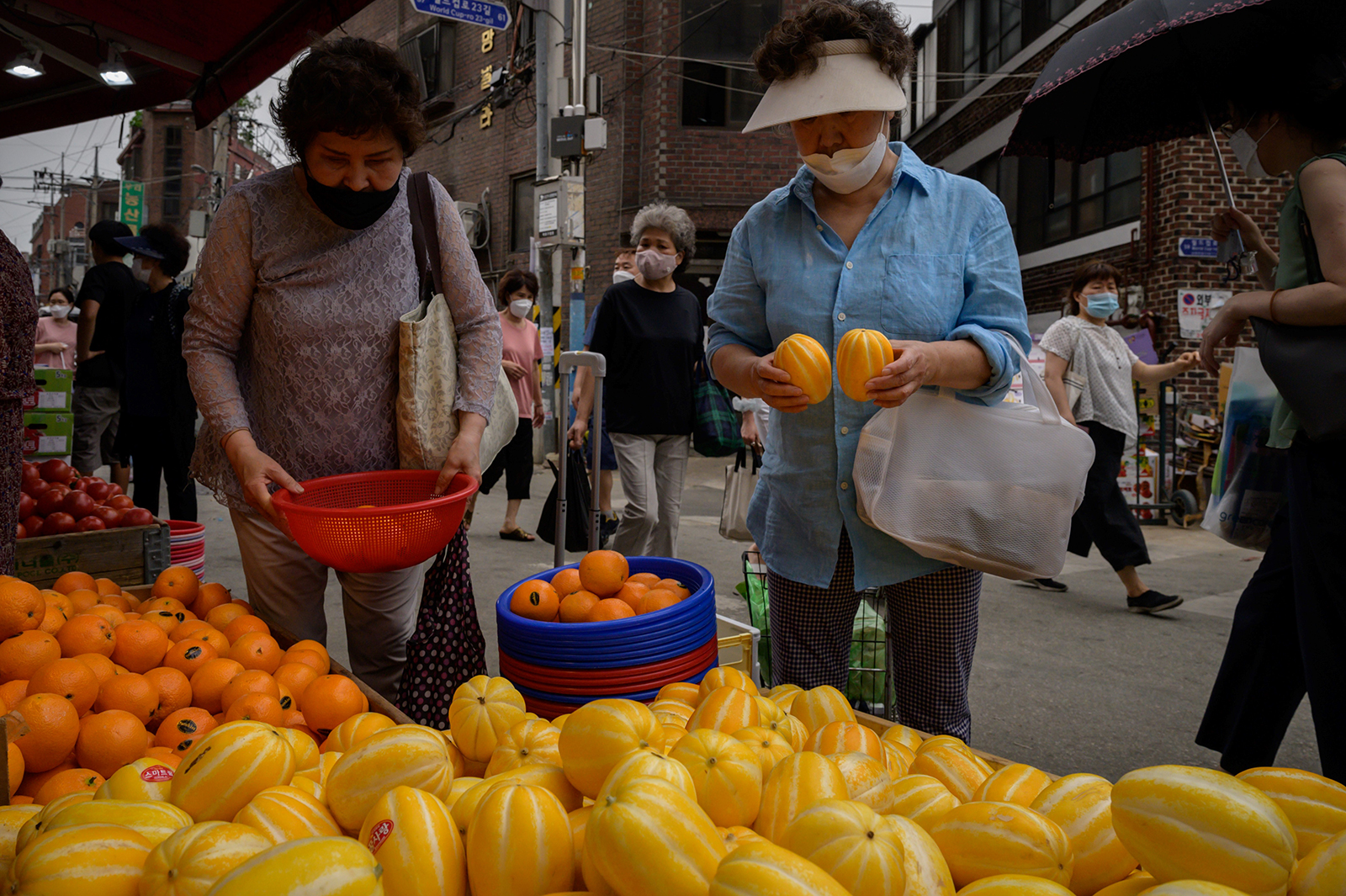
Shoppers walk through a market in Seoul on June 10. Ed Jones/AFP/Getty Images
A second wave of coronavirus outbreak is already underway in South Korea, according to the Korea Centers for Disease Control and Prevention (KCDC).
KCDC director Jung Eun-kyeong told a briefing on Monday that the current wave began during the May holiday period.
She said the first wave ended in April after the number of daily new cases decreased to around 10 or below for a number of days before trending very slightly upward in early May.
Jung said it was hard to say whether this was a large-scale outbreak but regional outbreaks were occurring and more are expected.
With the number of cases expected to increase in the autumn and winter months, Jung added that health authorities are readying enough beds to deal with a large-scale outbreak.
According to the KCDC, 12,484 people in the country have so far been infected with the virus, with 280 deaths.
Source:https://edition.cnn.com/world/live-news/coronavirus-pandemic-06-23-20-intl/index.html
The French drug maker, Sanofi SA, says it expects to get approval for the potential Covid-19 vaccine it is developing with Britain’s GlaxoSmithKline Plc by the first half of next year, faster than previously anticipated.
Sanofi, which is hosting a virtual research and development event, and GSK had said in April that the vaccine, if successful, would be available in the second half of 2021.
“We are being guided by our dialogue with regulatory authorities,” Sanofi research chief John Reed told reporters, when asked about the accelerated time frame.
There are currently no vaccines to prevent the coronavirus that has infected more than nine million people and killed over 469,000 globally, and only a couple of medicines that have demonstrated benefit in hospitalised Covid-19 patients in clinical trials.
Many drugmakers are racing to come up with a safe and effective vaccine that can be produced at large scale. The Sanofi chief executive Paul Hudson said the firsts in the race now were not assured of securing victory, Reuters reports.
“There are companies moving faster, but let us be brutally clear, speed has three downsides,” he said of competition. “They are using existing work, in many cases done for Sars; it is likely not to be as efficacious; and there is no guarantee on supply in large volumes,” Hudson said.
The probability of success for Sanofi is “higher than anybody else,” the CEO said.
Here are the most important updates from the last few hours:
· Confirmed cases of coronavirus passed 9 million. According to Johns Hopkins University, which keeps a tally of official statistics, 9,079,452 cases have been reported. At least 471,754 people have died. The United States is the world’s worst affected country by case numbers, with more than 2.3 million cases and 120,402 deaths.
· Beijing reports 22 new cases. China reported 22 new coronavirus cases for June 22, 13 of which were in the capital Beijing, the National Health Commission said on Tuesday. This compared with 18 confirmed cases a day earlier, 9 of which were in Beijing. Another seven asymptomatic Covid-19 patients, those who are infected but show no symptoms, were reported for June 22, the same as a day earlier. China does not count these patients as confirmed cases.
· The US Covid-19 death toll passed 120,000. Tthe coronavirus death toll in the US has reached 120,340, according to the latest figures from John Hopkins University. Confirmed cases of Covid-19 in Florida have passed 100,000, while Covid-19 admissions at a chain of eight hospitals in Houston have tripled over the past month to 1400. An alarming 20% of Covid-19 tests in Arizona are coming back positive. The number of newly confirmed Covid-19 cases in the US has reached 26,000, up from 21,000 per day two weeks ago, according to an Associated Press analysis.
· Trump executive order extends a ban on employment-based visas through 2020. The Trump administration is temporarily suspending the entry of certain foreign workers to the United States in a move painted as freeing up jobs while the economy reels from the coronavirus pandemic, despite strong opposition from many businesses.
· California urges people to wear masks amid record Covid-19 hospitalisations. California officials implored residents to wear face masks and keep their distance from each other, after a record number of people were hospitalised with coronavirus over the weekend. Health officials warned that while the spread of disease seems to have stabilised in many parts of the state, metrics in some rural regions of southern and central California are cause for concern.
· WHO urges dexamethasone boom for worst virus cases. The World Health Organization called on Monday for a rapid increase in production of dexamethasone, a cheap steroid which has been shown to reduce deaths in critically ill coronavirus patients. WHO chief Tedros Adhanom Ghebreyesus said demand had already surged after a British trial of the drug was publicised but he was confident production could be ramped up.
· Texas to remain ‘wide open for business’ despite dramatic Covid-19 rise. Texas Governor Greg Abbott has said the state will remain “wide open for business” despite seeing a dramatic 10-day rise in Covid-19 hospitalizations and infections.An average of 3,200 Texans per day are now being admitted to hospitals, Abbott said, double the rate in mid-May. Abbott called on Texans to wear masks and continue social distancing to slow the spread of coronavirus but stopped short of making masks mandatory, and made no call for businesses to restrict services.
· Saudi Arabia closes borders to hajj attendees. Saudi Arabia said on Monday it will bar arrivals from abroad to attend the hajj this year due to the coronavirus, allowing only a limited number of Saudi citizens and residents to make the pilgrimage with social distancing measures enforced.
· Two more Trump staffers tested positive for coronavirus. Two more staff members of US president Donald Trump’s campaign who were in Tulsa, Oklahoma, for his rally on Saturday have tested positive for the coronavirus, after the campaign announced on Saturday hours before the rally that six members of the campaign’s advance staff had tested positive.
· The US suspended certain work visas and green cards until end of year. The government of the United States will suspend certain categories of non-immigrant work visas through the end of the year and extend an existing ban on certain green cards, as part of a move to protect US workers amid the economic devastation tied to the coronavirus pandemic.
· South Africa now has over 100,000 infections, the highest on the continent, while the number of deaths inched towards 2,000. Despite the grim death toll, data shows that the mortality rate in South Africa is at 2%, while 52.6% of virus patients have recovered. The worst-hit area is Western Cape, the coastal province accounting for 1,458 of the country’s deaths and more than half of its infections.
· Black Americans four times as likely as whites to be hospitalised with Covid-19. US government data released on Monday showed Black Americans were around four times as likely as whites to be hospitalised for Covid-19, highlighting significant racial disparities in health outcomes during the pandemic.
· Museums, galleries and cinemas will reopen in England from 4 July. Museums, galleries and cinemas in England will be allowed to reopen from 4 July, alongside pubs, restaurants and hairdressers, the British prime minister Boris Johnson will announce on Tuesday in a decisive but potentially risky easing of lockdown measures in England.